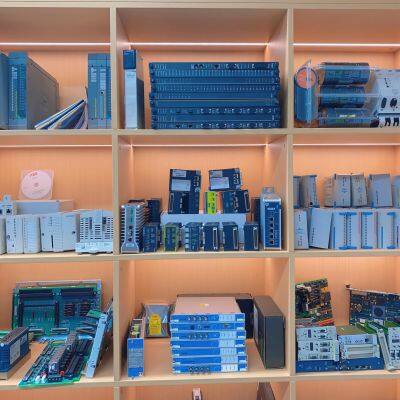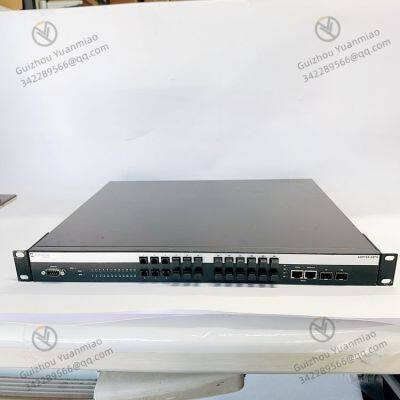Product Description
I. Core Product Positioning
The ENTERASYS A4H124-4FX P0973JN Ethernet Switch is a high-performance manageable switch specifically designed for industrial automation and enterprise-level network access scenarios. As a member of the Enterasys A4 Series, it features core advantages of "high stability, flexible port configuration, and strong environmental adaptability". It can serve as an access layer device in enterprise campuses, a connectivity solution for industrial workshop equipment, and a core switching node in small and medium-sized networks. The switch provides high-speed, non-blocking transmission channels for multi-service traffic such as data, voice, and video, and acts as a key hardware support for building reliable local area networks (LANs).
II. Core Hardware Configuration and Performance1. Port Layout and Transmission Capability
Flexible Port Combination Adaptation: Equipped with 24 10/100/1000BASE-T Gigabit copper ports + 4 1000BASE-FX Gigabit fiber ports (multi-mode fiber, SC interface). The copper ports support auto-negotiation (speed/duplex mode) and Auto-MDI/MDI-X (auto-crossover) functions, eliminating the need for manual switching. The fiber ports support multi-mode fiber transmission (62.5/125μm or 50/125μm) with a transmission distance of up to 550m (1000Mbps), meeting both short-distance copper port interconnection and medium-distance fiber expansion requirements.
Full Gigabit Non-blocking Architecture: Boasting a switching capacity of 56Gbps and a packet forwarding rate of 41.7Mpps, all ports support wire-speed forwarding. It can simultaneously handle full-load traffic from 24 Gigabit copper ports and 4 Gigabit fiber ports without packet loss or latency, satisfying scenarios such as high-definition video surveillance, real-time data interaction of industrial equipment, and concurrent access of multiple terminals in enterprise offices.
2. Industrial-grade Hardware Design
Wide Temperature Range and Environmental Tolerance: Adopting industrial-grade components, it operates within a temperature range of -10℃~+50℃ (enhanced commercial grade), with a storage temperature range of -40℃~+70℃ and a relative humidity of 5%~95% (non-condensing). It can operate stably in various environments such as enterprise computer rooms, industrial workshops (non-explosion-proof areas), and outdoor communication cabinets, with far superior resistance to temperature and humidity fluctuations compared to ordinary commercial switches.
Anti-interference and Physical Protection: It has passed EN 61000-6-2 (industrial environment immunity) and EN 61000-6-3 (emission, Class B) electromagnetic compatibility (EMC) tests. In scenarios with strong electromagnetic interference (such as motor start/stop and frequency converter operation), network transmission performance remains unattenuated. The switch features a 1U rack-mount metal chassis, providing excellent heat dissipation and shock resistance (complying with IEC 60068-2-27 shock standard: 15g acceleration, 11ms duration).
III. Key Functions and Technical Advantages1. Comprehensive Network Management Capability
Multi-mode Management Support: Supports Web-based graphical management (intuitive configuration interface, no professional commands required), CLI (Command Line Interface) management (via Console port or SSH/Telnet), and SNMP v1/v2c/v3 (compatible with mainstream network management platforms such as SolarWinds and HP OpenView). It caters to the operating habits of different technicians and simplifies network operation and maintenance.
Refined Traffic Control: Supports 802.1p priority (4 priority queues) and DSCP mapping, enabling priority classification of services such as voice (e.g., IP phones), video (e.g., surveillance cameras), and data (e.g., file transfers) to ensure bandwidth for critical services. It also supports port rate limiting (bidirectional Ingress/Egress rate limiting with a granularity of 1Kbps), preventing excessive bandwidth occupation by a single terminal and avoiding network congestion.
2. High Reliability and Security Protection
Link Redundancy and Self-healing: Supports STP/RSTP/MSTP spanning tree protocols, enabling the construction of ring network topologies. In case of a link failure, it can complete link switching within 2 seconds at the fastest to realize network self-healing. It also supports LACP (802.3ad) link aggregation, which can bind multiple physical ports into a logical link (up to 8 port aggregation groups), improving link bandwidth and redundancy capability and avoiding single-point link failures.
Multi-layer Security Policies: Supports 802.1X port authentication (protocols such as EAP-TLS/PEAP), allowing only authenticated terminals to access the network. It supports MAC address binding (static MAC/dynamic MAC learning restriction) to prevent MAC address spoofing and unauthorized terminal access. Additionally, it supports ACL (Access Control List), which can restrict data flows based on source IP, destination IP, port number, and protocol type, isolating different network segments and enhancing network security.
3. Flexible Network Expansion and Adaptation
VLAN Division and Interconnection: Supports IEEE 802.1Q VLAN (4094 VLANs), Private VLAN, and Voice VLAN (automatically identifies IP phones, separately divides VLANs and configures priorities). Virtual networks can be divided according to departments (e.g., enterprise offices) or device types (e.g., industrial sensors/cameras), reducing broadcast storms and improving network isolation and security. It supports VLAN Trunk (Trunk ports can carry multi-VLAN traffic), facilitating interconnection with upper-layer core switches.
IPv4/IPv6 Dual-stack Compatibility: Supports IPv4 static routing (up to 256 static routing entries) and basic IPv6 functions (such as IPv6 static routing and ICMPv6). It can adapt to the needs of enterprise networks transitioning from IPv4 to IPv6, featuring long-term technical compatibility and avoiding premature equipment obsolescence.
IV. Application Scenarios1. Enterprise and Campus Network Access Layer
Deployed in the floor distribution frames of enterprise office buildings and campus teaching buildings, it connects terminals such as employees' PCs, printers, and IP phones via 24 Gigabit copper ports, and connects to core switches (e.g., Enterasys A8 Series) via 4 Gigabit fiber ports to build a "core-access" two-layer network architecture. Leveraging Voice VLAN and QoS functions, it ensures clear and non-stuttering voice for IP phones, while meeting the needs of employees' daily office data transmission and high-definition video conferences.
2. Industrial Automation Equipment Interconnection
Applied in the device-layer network of automobile production lines and electronic manufacturing workshops, it connects equipment such as PLCs, industrial robots, sensors, and human-machine interfaces (HMIs) via Gigabit copper ports, and connects to industrial Ethernet switches (e.g., Enterasys C2 Series) via fiber ports to realize real-time data collection of equipment and transmission of control commands. With the help of STP/RSTP protocols, redundant links are built to prevent production line shutdowns caused by single-link failures and improve the reliability of industrial systems.
3. Security Monitoring and Multimedia Transmission
As an access switch in security monitoring systems, its 24 Gigabit copper ports can directly connect 24 Gigabit network cameras (POE power supply requires a matching POE injector; this model does not have native POE). The 4 fiber ports aggregate traffic to the core switch in the monitoring center. It supports video stream priority configuration to ensure real-time and delay-free transmission of high-definition monitoring images (1080P/4K). Meanwhile, it can connect access controllers and alarm devices to build an integrated security network.
4. Core Node of Small and Medium-sized Networks
Suitable as the full-Gigabit network core for small enterprises, stores, and branch offices. It directly connects terminal devices via copper ports, and uses fiber ports to connect to Internet dedicated lines (e.g., fiber broadband) or for cross-floor/cross-building network expansion. It implements internal and external network data forwarding using static routing functions, and combines ACL and 802.1X authentication to balance network convenience and security. There is no need to deploy additional core switches, reducing network construction costs.
V. Key Technical Parameters
VI. Core Product Value
Cost-effective Full Gigabit Solution: With a full Gigabit configuration of 24 copper ports + 4 fiber ports, it balances terminal access and network expansion. Compared with similar products, it has obvious advantages in switching capacity and packet forwarding rate, while supporting comprehensive management functions, offering outstanding cost-effectiveness.
Industrial-grade Stability and Commercial-grade Flexibility: It not only has industrial-grade environmental tolerance to adapt to non-explosion-proof industrial scenarios and complex enterprise environments but also retains the convenient management and flexible expansion features of commercial switches. This avoids the pain points of "functional redundancy" in industrial switches and "environmental fragility" in commercial switches.
Easy Deployment and Low O&M Costs: Web-based graphical management lowers the operation threshold. It supports integration with mainstream network management platforms; in case of faults, problems can be quickly located through SNMP alarms and port status indicators, reducing the investment in O&M personnel. The metal chassis and industrial-grade components extend the service life of the equipment, reducing replacement frequency and total cost of ownership (TCO).


ICS TRIPLEX TC-201-01-4M5 Chassis Power Cable
ABB DDC779BE02 3BHE006805R0002 Circuit Card
ICS TRIPLEX TC-215-01-4M5 Chassis Power Cable
ICS TRIPLEX TC-303-01-2M0 Chassis Power Cable
Vibro-meter SIM-275D-24 200-582-200-011 Power Supply Module
ICS Triplex T8461 Digital Output Module TMR 24 Vdc
ABB AIM0006 2RCA021397A0001P PC Board Interface
HIMA X-BLK01 632590802 Blank module
HIMA X-DI1601 985210222 Digital Input Module
GE 531X121PCRALG1 POWER CONNECT CARD
GE 369-H1-R-M-F-E-H-E Generator protection Relay
GE CT11T7F10PN1 PMC676RCTX V2.3 01 16 C1145 CR11 V2.x interface board
 yezi
Hi there! Welcome to my shop. Let me know if you have any questions.
yezi
Hi there! Welcome to my shop. Let me know if you have any questions.


